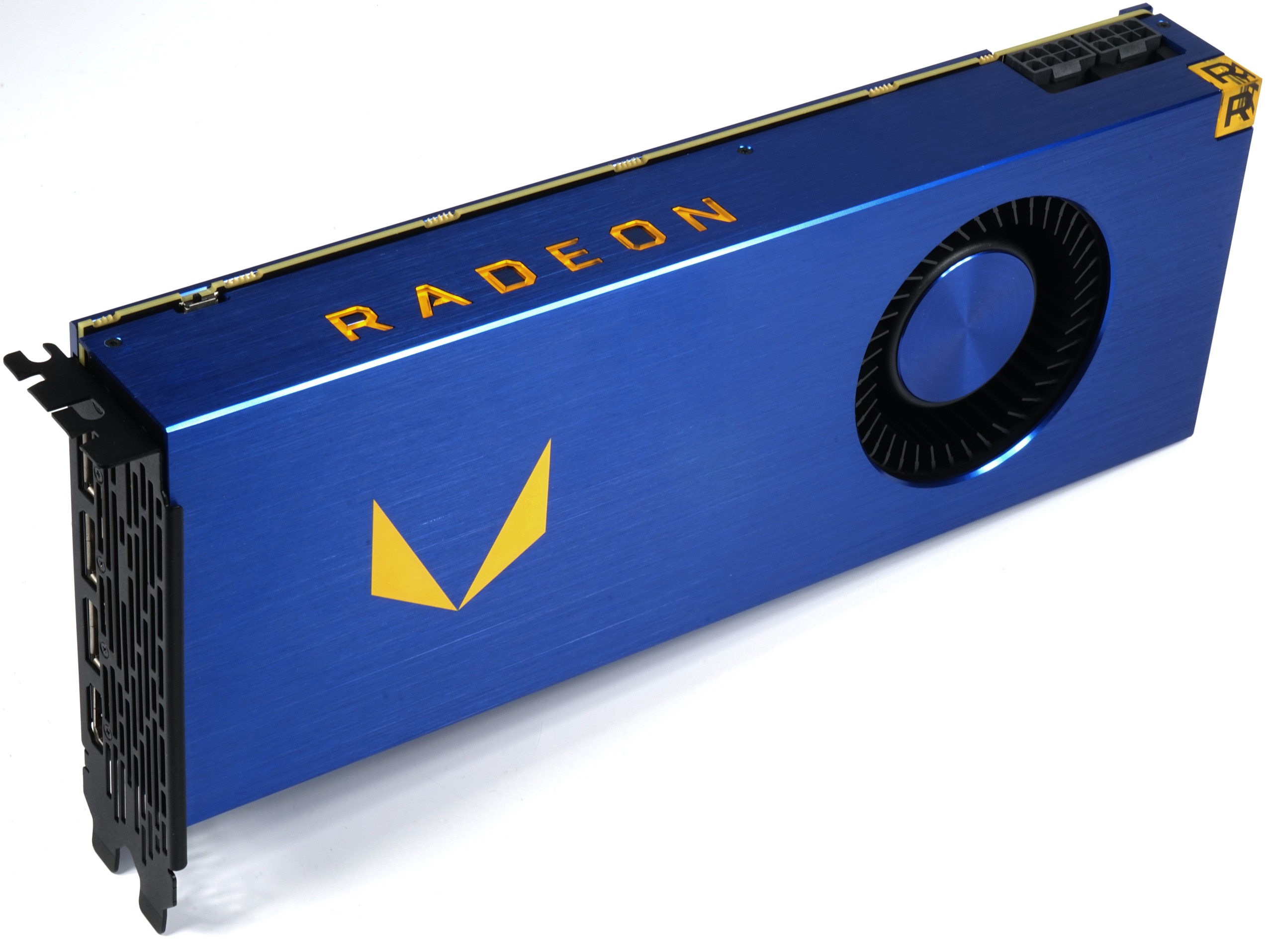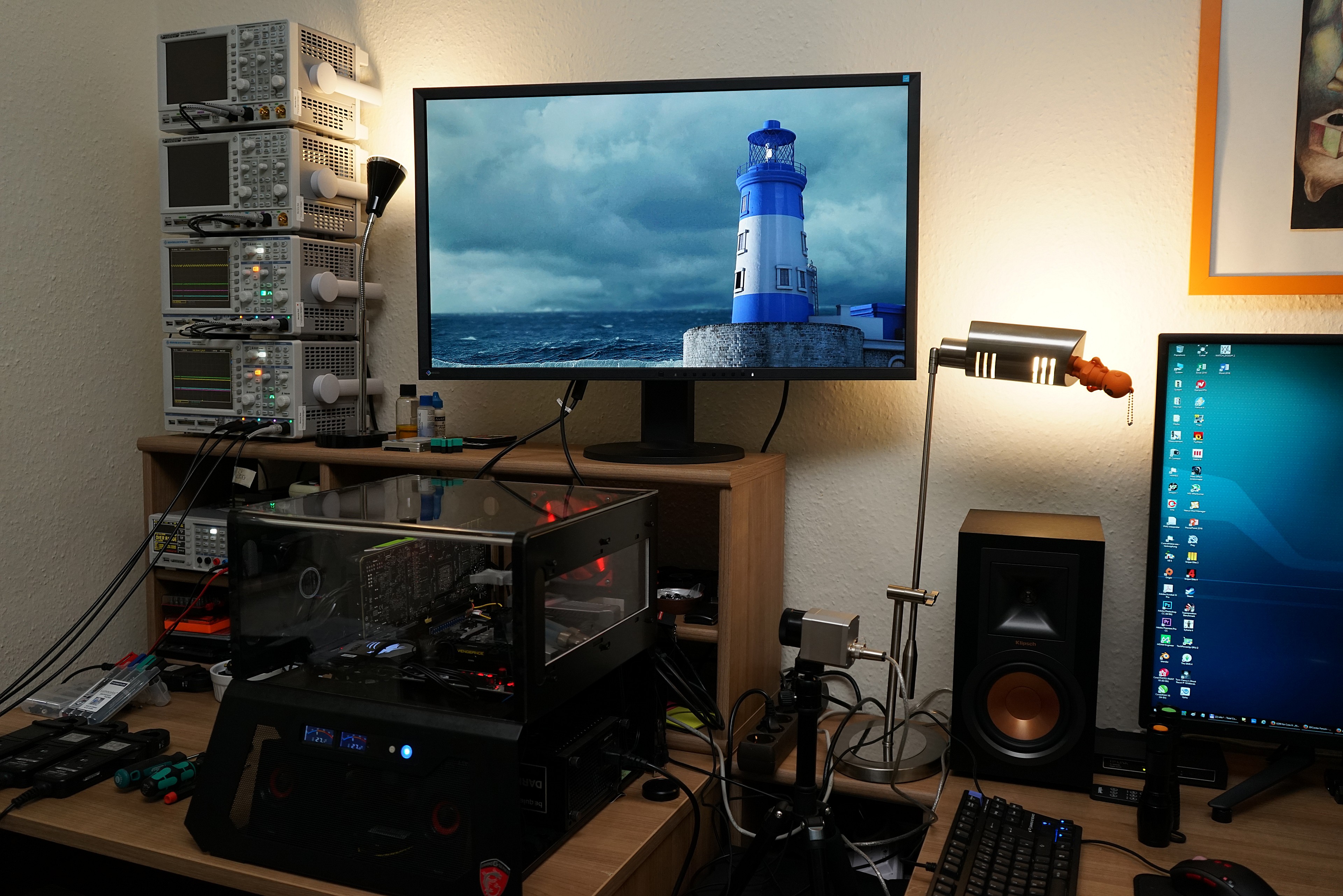Early Verdict
AMD's Radeon Vega Frontier Edition performs well in targeted professional applications thanks to support for Radeon Pro certified drivers. However, it isn't as fast as many prosumers might have hoped in games. While it's possible that a forthcoming software update improves performance, the already-announced Radeon RX Vega 64 should be comparable (and less expensive) for gaming-only.
Pros
- +
Pro driver-enabled
- +
High-quality thermal solution
- +
Inexpensive (vs. workstation cards)
Cons
- -
Lower-than-expected gaming performance
- -
High power consumption
Why you can trust Tom's Hardware
Meet AMD’s Radeon Vega Frontier Edition
AMD’s goal with its Radeon Vega Frontier Edition seems clear: try to do everything well. Nvidia has to segment its portfolio carefully; it doesn't want to cannibalize sales of the Quadro P6000 with Titan Xp. But AMD doesn't have that problem. Radeon RX Vega 64 isn't here yet, so pros and gamers alike are putting the Frontier Edition board through its paces.
The company even encourages this by allowing the Radeon Vega Frontier Edition card to use AMD's Radeon Pro certified drivers, without which many workstation-class applications won't even start. The same can’t be said for Nvidia’s Titan Xp. No matter if you’re a prosumer who dabbles in high-end hardware for work and play, or a scientist eager to access lots of floating-point compute performance, this card is supposed to be a jack-of-all-trades.
Because we're still waiting for the Vega card meant to address gamers, we're not going to focus on that market exclusively (although we do have gaming benchmarks to show as well). Instead, you'll see us mix it up with workstation-class comparisons and high-end desktop cards. Included in the mix is Nvidia's Quadro P6000, which is around three times more expensive than AMD's Frontier Edition board.
Look, Feel & Connectors
AMD's Radeon Vega FE weighs in at a solid 1050g. Its length, from the slot bracket's edge to the end of the cooler, is 26.8cm. Its height, from the bottom of the PCIe slot to the cooler's top, is 10.5cm. A depth of 3.5cm makes this a true dual-slot card, with the backplate needing another 0.4cm of clearance on the other side.
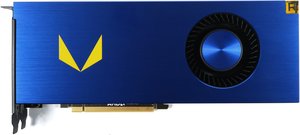
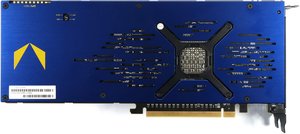
Both the card’s cover and backplate are made of blue anodized aluminum that has a high-quality feel to it. All of the screws are painted black. A Radeon logo printed on the cover and the logo cube provide the only splashes of dissimilar color. This follows the theme of AMD's other Pro WX cards, though Vega FE's blue is noticeably darker and more saturated.
The card's top sports a pair of eight-pin auxiliary power connectors, as well as the aforementioned Radeon logo cube that lights up yellow. It's made from acrylic and recessed into the card’s cover.
The Radeon Vega FE's end is closed. It sports mounting holes, which are fairly standard for workstation-oriented graphics cards. Around front, the matte black anodized slot cover hosts three DisplayPort connectors and one HDMI 2.0 output. The omission of DVI connectivity makes sense from an airflow perspective; the slot cover also serves as the card's exhaust vent and needs to be as free-flowing as possible.
Get Tom's Hardware's best news and in-depth reviews, straight to your inbox.
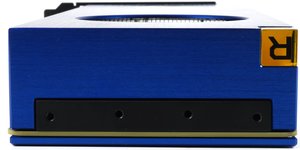
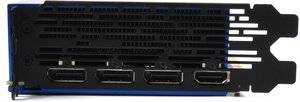
| Model | Radeon Vega FE | Radeon R9 Fury X | Titan Xp | Quadro P6000 | GeForce GTX 1080 Ti |
|---|---|---|---|---|---|
| GPU | Vega 10 | Fiji XT | GP102 (450-A1) | GP102 (350-K1-A1) | |
| GPU Size | 486mm² | 596mm² | 471mm² | 471mm² | |
| Transistors | 12.5 billion | 8.9 Billion | 12 Billion | 12 Billion | |
| GPU Clock Frequency (Base/Boost) | 1382 MHz1600 MHz | Unknown1050 MHz | 1480 MHz1582 MHz | 1506 MHz1645 MHz | 1480 MHz1582 MHz |
| Shaders/SIMD | 4096/64 | 4096/64 | 3840/30 | 3584/28 | |
| Texture Units/ROPS | 256/64 | 256/64 | 240/96 | 224/88 | |
| Pixel Fillrate | 88.4 GPixel/s | 67.2 GPixel/s | 151.9 GPixel/s | 144.6 GPixel/s | 141.7 GPixel/s |
| Texture Fillrate | 353.8 GTexel/s | 268.8 GTexel/s | 379.7 GTexel/s | 361.4 GTexel/s | 354.1 GTexel/s |
| Memory Bus | 2048-bit | 4096-bit | 384-bit | 352-bit | |
| Memory Type | HBM2 | HBM | GDDR5X | GDDR5X | |
| Memory Bandwidth | 483.8 GB/s | 512.0 GB/s | 547.6 GB/s | 432.0 GB/s | 484.0 GB/s |
| Memory Data Rate | 1.89 Gb/s | 1.0 Gb/s | 11.4 Gb/s | 9 Gb/s | 11.0 Gb/s |
| Memory Size | 16GB | 4GB | 12GB | 24GB | 11GB |
| DX12 Feature Level | 12_1 | 12_0 | 12_1 | 12_1 | |
| Aux. Power Connectors | 2× 8-pin | 2× 8-pin | 6 + 8-pin | 8-pin | 6 + 8-pin |
| TDP | 300W | 275W | <250W | <225W | <250W |
Test System & Methodology
We introduced our new test system and methodology in How We Test Graphics Cards. If you'd like more detail about our general approach, check that piece out. Note that, in order to avoid any potential CPU bottlenecks when testing AMD's powerful graphics card, we've upgraded our CPU and its cooling solution in the meantime.
The hardware used in our lab includes:
| Test Equipment & Environment | |
| System | - Intel Core i7-6900K @4.3 GHz- MSI X99S XPower Gaming Titanium- Corsair Vengeance DDR4-3200- 1x 1TB Toshiba OCZ RD400 (M.2, System)- 2x 960GB Toshiba OCZ TR150 (Storage, Images)- be quiet! Dark Power Pro 11, 850W Power Supply Unit (PSU) |
| Cooling | - Alphacool Eisblock XPX- Alphacool Eiszeit 2000 Chiller- 2x Be Quiet! Silent Wings 3 PWM (Closed Case Simulation)- Thermal Grizzly Kryonaut (Used when Switching Coolers) |
| PC Case | - Lian Li PC-T70 with Extension Kit and Mods - Configurations: Open Benchtable, Closed Case |
| Monitor | - Eizo EV3237-BK |
| Power Consumption Measurement | - Contact-free DC Measurement at PCIe Slot (Using a Riser Card) - Contact-free DC Measurement at External Auxiliary Power Supply Cable - Direct Voltage Measurement at Power Supply - 2x Rohde & Schwarz HMO 3054, 500MHz Digital Multi-Channel Oscilloscope with Storage Function - 4x Rohde & Schwarz HZO50 Current Probe (1mA - 30A, 100kHz, DC) - 4x Rohde & Schwarz HZ355 (10:1 Probes, 500MHz) - 1x Rohde & Schwarz HMC 8012 Digital Multimeter with Storage Function |
| Thermal Measurement | - 1x Optris PI640 80Hz Infrared Camera + PI Connect - Real-Time Infrared Monitoring and Recording |
| Noise Measurement | - NTI Audio M2211 (with Calibration File, Low Cut at 50Hz) - Steinberg UR12 (with Phantom Power for Microphones) - Creative X7, Smaart v.7 - Custom-Made Proprietary Measurement Chamber, 3.5 x 1.8 x 2.2m (L x D x H) - Perpendicular to Center of Noise Source(s), Measurement Distance of 50cm - Noise Level in dB(A) (Slow), Real-time Frequency Analyzer (RTA) - Graphical Frequency Spectrum of Noise |
| Drivers | - Radeon: 17.20.1035- Quadro: R381 U2 (382.05) |
| Operating System | - Windows 10 Pro (Creators Update, All Updates) |
MORE: Best Graphics Cards
MORE: Desktop GPU Performance Hierarchy Table
MORE: All Graphics Content
Current page: Meet AMD’s Radeon Vega Frontier Edition
Next Page Vega Architecture & HBM2
Igor Wallossek wrote a wide variety of hardware articles for Tom's Hardware, with a strong focus on technical analysis and in-depth reviews. His contributions have spanned a broad spectrum of PC components, including GPUs, CPUs, workstations, and PC builds. His insightful articles provide readers with detailed knowledge to make informed decisions in the ever-evolving tech landscape
-
Ne0Wolf7 Too bad its been so well optimized for Creo, I hate that one... Anyways, is it possible to include Autodesk Inventor in the suite? I want a card that can be used as a hybrid like this (of course I'll have to wait for it to come down in price) but its hard to decide I want something if my main software is not included in the benchmarks. Either way, I'm exited and this is a good reviewReply -
cknobman Not sure what to think here (in regards to hopes for the fx versions).Reply
I cannot expect to see a huge % boost in games just on a driver update. Maybe 10% tops?
What bothers me the most is the heat/power and throttling concerns.
I dont think those will change with a fx version of the card.
So it would appear that 80-90% of the time Vega 64 will be running closer to 1200mhz, which is a major bummer and why it wont surpass a 1080.
Almost wish there had been a review of the watercooled version as well to see if it was able to maintain higher avg mhz. -
cats_Paw Dont know much about workstation so my comment does not take that into consideration.Reply
It seems like it eats a lot of power for a very similar performance to a 1080 in gaming but at the same time its faster than Titan Xp in some workstations?
Doesn't that suggest driver/optimization issues? -
Yarvolino Ho comes that Vega and 1080Ti specs are pretty much the same, even greater numbers for Vega, and the result is that Vega is 40% slower and it drains +50% of power ?Reply
Considering Vega also costs much more, I label it as an april fool -
LORD_ORION Wow, what a horrible review.Reply
2 games, 1 resolution... and just where does this card fit in the vega lineup? You didn't even list the details of the other vega cards in a handy chart for comparison.
*starts looking for reviews on other sites* -
demonsoldier So there has been a few people tackling this and i found that lowering certain things about the card undervolting by 110mv has found to fix the clock speed issue keeping at a stable 1600 mhz with better cooling and it out performs the 1080 at that point. Can you guys do a second attempt at this with undervolts to see if that helps anything? AMD cards have been this way everytime they come out needing to have power draw issues fixed later on.Reply -
sparkyman215 Reply20013128 said:Wow, what a horrible review.
2 games, 1 resolution... and just where does this card fit in the vega lineup? You didn't even list the details of the other vega cards in a handy chart for comparison.
*starts looking for reviews on other sites*
wh-what? Toms stated like four times that this *is not a gaming card* and shouldn't be treated as one. They simply included the gaming benchmarks to be inclusive. Also, there's not really a point in showing benchmarks under 4k for such high end cards, because at that point (like 1080p) it's a CPU bottleneck - the GPU has nothing much to do. Considering listing other Vega cards, those are in a different class and not relevant, however it would be nice to have the details of the other cards, I guess. -
yeeeeman Even though AMD says with each ocassion that this graphics card is not indicative of RX Vega's performance I would say that they are trying to avoid early dissapointment. The matter of the fact is that whatever feature they have disabled right now on Vega FE, it won't bring too much performance on RX Vega. Lets face it, if they were using half of CUs on Vega FE, then I would expect huge gains from RX Vega, but as it stands, RX Vega wil be ~ GTX 1080, one year later, + 100W and hot like a stove.Reply
I really wonder how could they make a new GPU on a big better process (28nm vs 14nm) and still get more power consumption compared to Fury X. What is more surprising is that they have the same number of CUs, approx same performance with Fury X, a lot more transistors, a lot more frequency and still the improvement is minimal.
They are either hiding some huge block which doesn't do anything in graphics scenarios which consumes a lot of power just idling or they are rubbish at power optimization or maybe the HBM2 consumes a lot of power, don't know.
Everything on this card is strange, starting with performance, specs, power consumption, everything... -
Pompompaihn Seems like a very nice card if you're a home office person and need your system to do double duty. Good enough for high end gaming and comparable to expensive NVIDIA pro cards.Reply
